ASHP retrofit
– one family’s journey
On 3 August 2021 the kit for our air source heat pump arrived together with the installers. Greenway Energy is a small family business specialising in heat pumps and solar PV. They worked in a tidy and efficient way to complete the job as planned two days later. The process was managed with minimal disruption, helped by the fact that heating is not required in summer.
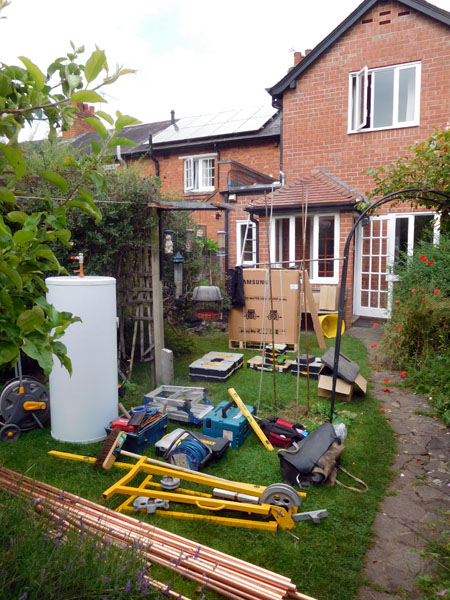
ASHP kit arrives ready for installation, 3 August 2021
Originally the idea was for a hybrid ASHP, such as the Daikin Altherma Hybrid model, due to the concern that a full hybrid may not be able to meet the peak winter demand. SAP calculations indicated that the house with the existing gas boiler was responsible for 2.8 t/y of CO2 emissions, which would reduce to 1.3 tCO2/y with the hybrid ASHP or 0.4 tCO2/y with a full ASHP. Therefore to achieve the maximum reduction in CO2 emissions and not to have both a gas boiler and ASHP to maintain, it was decided to take the plunge and have an ASHP to provide all heating and hot water.
Then in September 2020 the Green Homes Grant was launched which was an added incentive. Various ASHP models were considered particularly with regards to maximum temperature, coefficient of performance and ecologically friendly refrigerant. An 8 kW sixth generation Samsung monobloc emerged as the favourite. Quotations varied between £8000 and £14,000. The lowest quote, by Greenway Energy, was for the preferred Samsung model. Two previous customers provided very good references for the installer.
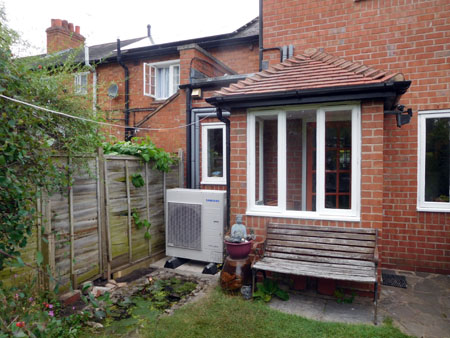
ASHP installation completed, 5 August 2021
The monobloc unit is located under the kitchen window as shown in the photograph. The flow and return pipework with its grey insulation can be seen entering the building at first floor level above the porch, where it enters a built-in cupboard which used to house the gas boiler. A hot water tank is now in that cupboard together with the control unit, two expansion vessels and a pump.
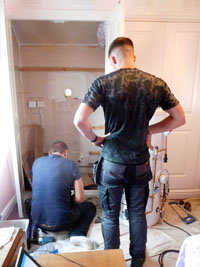 Installation in progress. Note the circular hole in the wall where the gas boiler flue used to be
Installation in progress. Note the circular hole in the wall where the gas boiler flue used to be
We have had the opportunity to get to used to the ASHP gradually, initially generating hot water only and subsequently providing central heating as well now that we are in November.
Original estimates indicated that energy costs would increase by £200 switching from gas to electricity. However more refined modelling using details of the particular ASHP and the current energy costs now indicate that the increase would only be £10 per year. This will be more than offset by RHI payments of £165 per year. In recent months gas prices have been climbing faster than the cost of electricity, making the transition to electricity more attractive than previously.
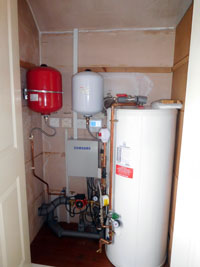 The hot water tank and associated control and pipework is located in a built-in cupboard that used to house the gas boiler
The hot water tank and associated control and pipework is located in a built-in cupboard that used to house the gas boiler
It is early days to conclude whether the radiators are large enough to ensure thermal comfort throughout the winter. We are learning how to best control the system. The hot water is set to come on at 4am, followed by the central heating at 4:30 to allow for a gradual heat up period. The daytime set point is 20°C with 17°C setback at night.
We are enjoying the gentle and steady warmth throughout the day, with the ASHP modulating to produce just the required heat at a steady rate. The ASHP includes weather compensation to control the flow temperature according to the outside temperature. If, come the winter, the central heating is not producing sufficient heat to keep us comfortable, we may need to make adjustments to the system or possibly install an additional radiator. But so far: so good.
Considerations
The outdoor unit
This should be located reasonably close to the hot water tank so as to minimise heat loss. The outside unit does make a noise, somewhat more than I had anticipated. Also it blows out cold air. Water condenses from the unit making a puddle underneath. These factors need to be anticipated and catered for. A monobloc is larger than the outdoor part of a split unit. However, a split ASHP, has an additional unit to be situated inside the house.
Indoor
The indoor kit, consisting of a hot water tank etc. takes up more space than the gas boiler it replaced. As a consequence there is less space for storage in the airing cupboard.
Heat output
If your house is old and hard to heat the ASHP may struggle to deliver sufficient heat to keep the house warm. Consideration may need to be given to upgrading the house insulation, reducing unnecessary draughts (but ensuring sufficient ventilation) and possibly installing larger radiators.
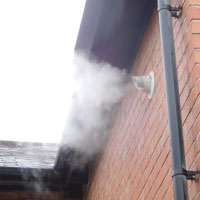 The old gas boiler was very effective in producing heat, but it also produced tonnes of CO2
The old gas boiler was very effective in producing heat, but it also produced tonnes of CO2
Even though our house is old and potentially hard to heat, we had already undertaken various energy efficiency measures including cavity wall insulation. And therefore we decided to give it a go. Swapping the heating system went very smoothly for us. The only downside as far as we are concerned is that it produces more noise than I had expected. Overall I would say that this little inconvenience is a small price to pay to enable a big reduction in climate changing CO2 emissions.
